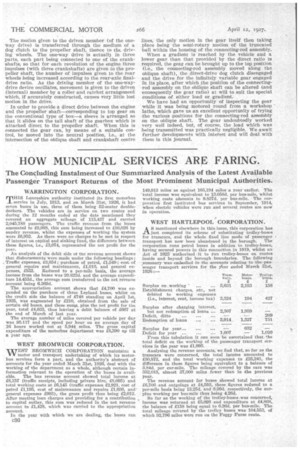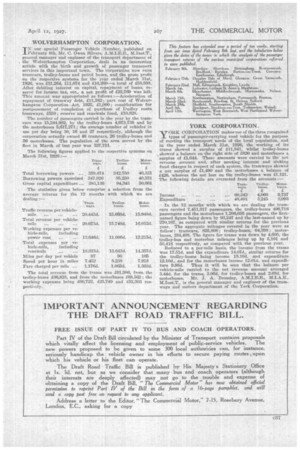HOW MUNICIPAL SERVICES ARE FARING.
Page 58

Page 59

If you've noticed an error in this article please click here to report it so we can fix it.
The Concluding Instalment of Our Summarized Analysis of the Latest Available Passenger Transport Returns of the Most Prominent Municipal Authorities.
WARRINGTON CORPORATION.
MHIS Lancashire authority instituted its first motorbus service in July, 1913, and on March 31st, 1926, it had seven buses in use, three of them being 52-seater doubledeckers. The vehicles are in service on two routes and during the 12 months ended at the date mentioned they covered an aggregate mileage of 115,437 and carried 2,045,783 passengers. The traffic revenue from the buses amounted to 19,988, this sum being increased to 110,026 by sundry revenue, whilst the expenses of working the system were £6,952. As there were no charges to be met in respect of interest on capital and sinking fund, the difference between these figures, i.e., £3,074, represented the net profit for the year.
An analysis of the debit side of the revenue account shows that disbursements were made under the following headings : , Traffic expenses £3,854; purchase of petrol, £1,549; eost of general repairs and maintenance, £1,010, and general ex
penses, £532. Reduced to a per-mile basis, the average income from the buses was .20.822d. and the average expenditure 14.453d., the average sum transferred to the net revenue account being 6.369d.
The appropriation account shows that £4,700 was expended on the purchase of three Leyland buses, whilst on the credit side the balance of £748 standing on April 1st, 1925, was augmented by 1210, obtained from the sale of certain old buses, and these sump, plus the net profit for the year, total £4,033, thus leaving a debit balance of 1667 at the end of March of last year.
The average number of miles covered per vehicle per day was 95.117 and the speed per hour on an average day of 1.6 hours worked •out at 5.944 miles. The gross capital expenditure of the motorbus department was 18,390 up till a year ago.
WEST BROMWICH CORPORATION.
IATEST BROMWICH CORPORATION maintain a s, motor and transport undertaking of which its motorbus services form a part, and the authority's abstract of accounts for the year ended March 31st, 1926, deal with the working of the department as a whole, although certain information relevant to the operation of the buses is available. The bus revenue account showed total income at 13,157 (traffic receipts, including private hire, .£8,095) and total working costs at £6,145 (traffic expenses 12,921, cost of petrol 11,195, ccst of maintenance and repairs 11,036, and general expenses 1993), the gross profit thus being £2,012. After meeting loan charges and providing for a contribution to capital outlay, this sum was reduced in the net revenue account to 11,428, which was carried to the appropriation account.
In the year with which we are dealing, the buses ran 149,913 miles as against 105,194 miles a year earlier. The ' total income was equivalent to 13.0580. per bus-mile, whilst working costs amounts to 9.837d. per bus-mile. The corporation first instituted bus services in September, 1914, when electric vehicles were run and several routes are now in operation.
WEST HARTLEPOOL CORPORATION.
AS mentioned elsewhere in this issue, this corporation has just completed its scheme of substituting trolley-buses for tramcars, and the whole fixed line mode of passenger transport has now been abandoned in the borough. The corporation runs petrol buses in addition to trolley-buses, having secured powers in this connection in 1919, whilst au Act of 1923 authorized it to run trolley-buses on routes inside and beyond the borough boundaries. The following summary was embodied in the accounts relating to the pas. senger transport services for the Aar ended March 31st, 1926:—
From this tabulation it can soon be ascertained that the total deficit on the working of the passenger transport s'ervices in the year was £1,995.
Analysing the revenue accounts, we find that, so far as the tramcars were concerned, the total income amounted to 130,873, and the total working expenses to £25,241, the difference in these figures being equivalent to a balance of 8.840. per car-mile. The mileage covered by the cars was 352,015, almost 37,000 miles fewer than in the previous year.
The revenue account for buses showed total income at 16,706 and outgoings at £4,553, these figures reduced to per-mile basis being 13.25d. and 3.990. respeotively, the surplus working per bus-mile thuS being 4.26d. So far as the working of the trolley-buses was concerned, income was returned at 15,026 and expenditure at 14,863,, the balance of £158 being equal to 0.36d. per bus-mile. The total mileage covered by the trolley buses was 104,553, of which 92,796 miles were run on the Foggy Furze route.
WOLVERHAMPTON CORPORATION.
IN our special Passenger Vehicle Number, published on February 8th, Mr. C. Owen Silvers, M.Inst.T., general manager and engineer of the transport department of the Wolverhampton Corporation, dealt in an interesting article with the birth and growth of passenger transport services in this important town. The corporation now runs tramcars, trolley-buses and petrol buses, and the gross profit on the respective systems for the year ended March 31st, 19245, was £31,264, £11,074 and £16,260—a total of £58,598. After .debiting interest on capital, repayment of loans, reserve for income tax, etc., a net profit of 123,769 was left. This amount was appropriated as follows :—Acceleration of repayment of tramway debt, 111,382; part cost of Wolverhampton Corporation Act, 1925, £1,000; consideration for postponement of completion of purchase of Dudley route tramways, £559; reserve and renewals fund, £10,828.
The number of passengers carried in the year by the tramcars was 15,244,982, by the trolley-buses 4,673,739 and by the motorbuses 5,617,271; the average number of vehicles ill use per day being 30, 16 and 27 respectively, although the corporation actually owned 46 tramcars, 26 trolley-buses and 36 motorbuses. The po.pulation of the area served by the Beet in March of last year was 337,751.
The following figures applied to the respective systems on March 31st, 1926:—
Miles per day per vehicle 97 96 105 Speed per hour in miles 7.452 8.238 7.918 Fare charged per mile .. 1.176d. 1.065d. 1.363d.
The total revenue from the trams was £91,986, from, the trolley-buses £311,823, and from the motorbuses £68,562; the working expenses being £60,722, 125,749 and £52,303 respectively.
YORK CORPORATION, ATORIC CORPORATION makes-use of the three neognized types of passenger-carrying road vehicle for the purpose of meeting the transporf needs of the local population, and in the year ended March 31st, 1926, the working of its trams showed a surplus of £11,841, whilst trolley-buses showed a balance on the right side of £820 and motorbuses a surplus of £1,644. These amounts were carried to the net revenue account and, after meeting interest and sinking fund charges in respect of each system, the tramways showed a net surplus of £1,490 and the motorbuses a balance of £426, whereas the net loss on the trolley-buses was £1,121. The following details are extracted from the accounts :— TramTrolleyMotor•
ways. buses. buses.
Income ... ... 60,242 4,088 9,737 Expenditure ... 48,401 3,245 8,093 In the 12 months with which we are dealing the tramcars carried 7,451,917 passengers, the trolley-buses 496,716 passengers and the motorbuses 1,206,655 passengers, the firstnamed figure being down by 93,247 and the last-named up by 270,187, as compared with similar returns for the previous year. The aggregate mileages covered in the year were as follow: tramcars, 825,808; trolley-buses, 64,398; motorbuses, 194,498. The figure for trains was down by 4,805, the trolley-bus and motorbus mileages being up by 5,101 and 50,418 respectively, as compared with the previous year.
Reduced to a per-mile basis, the income from the trams was 17.51d. and the expenditure 14.07d., similar returns for the trolley-buses being income 15.16d. and expenditure 12.10d., and for the motorbuses income 12.01d. and expenditure 9.98d. Thus it will be seen that the balance per vehicle-mile carried to the net revenue account averaged 3.44d. for the trams, 3.06d. for trolley-buses and 2.03d. for motorbuses. Mr. J. A. Bromley, A.M.I.E.E., M.I.A.E.. M.Inst.T., is the general manager and engineer of the tramways and motors department of the York Corporation.












































































































